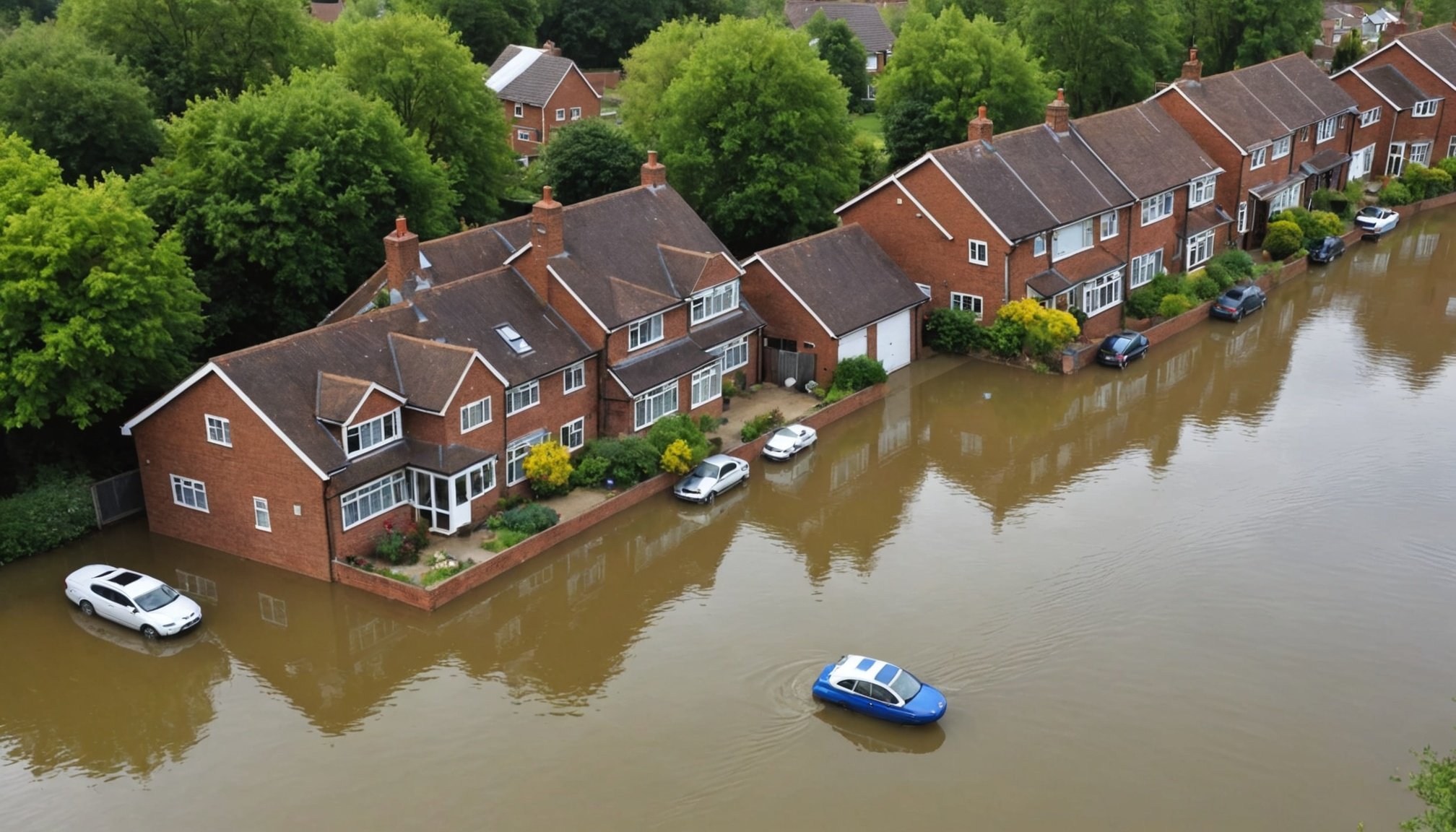Understanding Flood Risks in High-Risk Areas
Navigating the complexities of flood risk assessment in the UK is crucial for protecting communities. The nation has seen an uptick in severe weather events, making it imperative to identify high-risk areas. These are often located near coastlines, rivers, or low-lying regions. The Environment Agency categorises these areas as UK flood zones, each with varying levels of danger and probabilities of flooding. Zones are ranked from high to low risk, offering a framework for understanding potential impacts.
To accurately assess local flood risks, homeowners should collect data from reliable sources like the Environment Agency’s flood maps or local council information. Methods involve evaluating historical flooding events, current flood defences, and projected trends. Conducting a thorough flood risk assessment helps pinpoint vulnerabilities and strengthens emergency preparedness.
In parallel : Mastering the UK”s Stamp Duty Surcharge: A Guide for Foreign Buyers
Homeowner awareness is paramount in managing flood impact. Understanding one’s flood zone, preparing an emergency plan, and being vigilant about weather updates empower individuals to act swiftly during crises. Community involvement, such as participating in local meetings and flood defence projects, enhances resilience. A collaborative effort ensures better resource allocation and reduces potential flood damage, preserving lives and properties.
Property Modifications for Enhanced Resilience
Addressing the challenges of floods, flood-resistant construction and strategic property modifications are paramount. One essential modification is the installation of elevated foundations. Elevated foundations are particularly useful in areas prone to frequent flooding, allowing water to flow beneath a property without causing damage. Another effective solution is the addition of flood barriers. These barriers, often removable, offer protection against rising waters, safeguarding interiors.
Additional reading : Essential Compliance Guide for Landlords in Wales: Mastering Rent Smart Wales Regulations
In the UK, implementing such property modifications is guided by certain building regulations. These regulations often require buildings in flood-prone areas to adhere to specific height and material requirements, ensuring structures are resilient. The UK government offers guidelines that property owners can refer to when considering these changes.
Successful examples of these modifications can be found in multiple UK regions. For instance, properties in Somerset and Cumbria have incorporated elevated designs and barriers that have proven effective during heavy floods. Such case studies illustrate the long-term benefits and importance of flood-resistant construction in preserving property integrity and ensuring safety.
By understanding and applying these building regulations and construction strategies, property owners can significantly mitigate flood risks, providing peace of mind and enhancing community resilience.
Landscaping Strategies to Mitigate Flood Impact
When considering landscaping for flood resilience, focusing on effective water flow and drainage solutions is crucial. Implementing green infrastructure can significantly bolster flood resilience. This approach includes the use of rain gardens and permeable paving, which are designed to manage excess water naturally and efficiently.
Rain gardens are shallow depressions planted with deep-rooted native vegetation that absorb rainwater runoff from impervious surfaces like roofs and pavement. They not only control water runoff but also support biodiversity by attracting pollinators. Such gardens are essential in urban settings where engineered solutions might disrupt local ecosystems.
Permeable paving solutions, like porous asphalt or interlocking concrete pavers, allow water to seep through the surface and percolate into the ground, minimizing surface runoff and reducing the strain on stormwater systems.
Examples of successful landscaping changes in high-risk areas highlight the transformative impact of these strategies. In cities prone to flooding, initiatives have shown that incorporating green infrastructure can lower flood risks while providing aesthetic and environmental benefits. Adopting landscaping techniques that incorporate these solutions can significantly improve a region’s resilience against flooding, making communities more robust and adaptable to climate change.
Choosing the Right Materials for Flood Resistance
In the quest for flood-resistant materials, making sustainable choices significantly impacts building durability over time. When considering materials that enhance flood resistance, it’s crucial to prioritise options like waterproofing and resilient insulation, which can serve as the first line of defence against water damage.
Waterproofing is fundamental. Consider materials that repel water, such as rubber membranes and liquid sealants, to ensure structures remain secure during heavy rains. Resilient insulation, like closed-cell spray foam or rigid foam boards, not only prevents water ingress but also retains buoyancy even in high exposure scenarios.
Sustainability plays a critical role in selecting these materials. Prioritising products with long-term durability means reduced replacement costs and lower environmental impact. Select sustainable choices like recycled or low-impact materials, which can withstand severe weather conditions while maintaining their integrity.
For practical application, look for suppliers offering materials with proven track records and certifications. Brands known for flood-resistant materials often provide guarantees on their product efficiency and environmental impact, ensuring peace of mind. Always explore options thoroughly, weighing both cost and benefit to ensure effective flood resistance and sustainability in your building projects.
Insurance and Financial Strategies
In today’s unpredictable climate, securing adequate flood insurance is a crucial step in safeguarding your home, particularly if you reside in high-risk areas. Engaging in comprehensive risk management can prevent substantial financial loss during emergencies. The complexity of choosing the right policy necessitates evaluating various insurance coverages to ensure they align with your specific needs.
When considering flood insurance, ensure that it encompasses not just structural repairs but also possessions within your home. This form of risk management should be tailored to reflect the potential threats in your locality. Consulting with professional advisors aids in understanding premium differences and coverage specifics, providing a clear perspective on your investment.
Financial planning plays an essential role in mitigating flood-related expenses. Establish an emergency fund specifically for flood-related emergencies. This buffer can cushion the immediate impact of damages, ensuring continuity. Additionally, explore third-party options such as government schemes that provide support in times of need.
Proactively addressing these elements forms part of a robust risk management strategy. Regularly reassessing your coverage and updating your financial plan are practical steps towards securing your home and financial future. Remember, preparation today could alleviate tomorrow’s potential financial burdens.
Government Resources and Community Initiatives
Enhancing flood resilience initiatives often requires collaboration between various sectors, particularly from the government and local communities. The government provides a variety of resources and grants aimed at bolstering flood resilience improvements. These resources can include funding for infrastructure upgrades, expert consultations, and technological installations designed to mitigate flood risks. By availing these tools, communities can effectively prepare and respond to potential flooding events.
Engaging in community action and local initiatives presents numerous benefits. Participation in these programs can foster a stronger sense of unity and shared responsibility among residents. By working together, communities enhance their collective resilience, gaining access to shared knowledge and resources that may not be individually attainable. Furthermore, community projects serve as a practical platform for implementing innovative flood-proofing techniques, significantly reducing vulnerability.
Several successful examples highlight how community action has driven impactful flood resilience projects. For instance, certain neighbourhoods have collaborated to create natural water retention systems, which effectively manage excess rainwater and reduce the burden on traditional drainage systems. These projects not only protect the physical environment but also empower communities by demonstrating the power of collective effort.
Practical Checklists and Action Plans
When it comes to fortifying your home’s flood resilience, having a structured approach is essential. A flood resilience checklist provides a comprehensive overview of crucial preventive measures. This includes ensuring that drains and gutters are clear, installing flood barriers, and securing electrical systems against water damage. Each of these steps plays a significant role in protecting your property.
For various property types, it is essential to have tailored action plans. For instance, homes with basements may require sump pumps, while houses on a slope might need retaining walls. Consistently updating your action plan according to your property’s needs is vital.
A key component of any preparedness strategy is regular review and updates. With the changing climate, flood risks can evolve, demanding that you reassess and refine your plan. Regular maintenance and assessments help ensure that your home remains safeguarded against potential flooding threats.
Implementing these actionable steps not only secures your residence but also grants peace of mind. By investing time in preventive measures, you’re making a proactive effort to protect your property against the unpredictability of flooding.
Expert Opinions and Resources
Staying informed about flood resilience techniques is crucial for homeowners and industry professionals alike. Experts in the field, such as Dr. Jane Thornback, emphasise the importance of proactive measures. She notes, “Investing in flood resilience now saves homeowners from overwhelming costs during disasters.” This expert advice on flood resilience highlights the need for both preventive measures and responsiveness during flood events.
For those seeking comprehensive resources, the National Flood Forum is a highly recommended organisation. Their website provides valuable tools and insights for homeowners aiming to bolster their properties against flooding. Additionally, the ‘Institute of Flood Management’ offers publications that delve into the latest industry insights and developments in the field.
One cannot overstate the importance of expert advice and staying updated on industry insights and best practices. These resources empower homeowners to make informed decisions that enhance their property’s flood resilience. Regularly engaging with these materials ensures that one is prepared for future challenges. By combining such expert advice with practical actions, resilience against floods becomes attainable. With a multitude of resources available, homeowners are well-positioned to fortify their properties using the latest knowledge and strategies.












